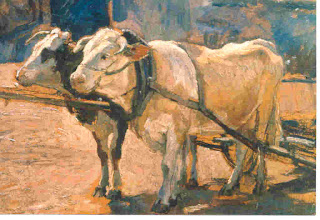Sep 28, 2008
Sep 6, 2008
Naši kiritofi su daleko a široko znami
Feast in Frielištof (Othmar Ružička)
Naši kiritofi su takaj daleko a široko znami. Pred kiritofom se cijev tajedan pripravlja, se se v stani liči a čisti. Aj ta najubožiji človik v seli si na kiritof pripravi ništa duobroga, pečena gusa muara bit na sakom stoli.
(Joza Sičan, the chairman of Narodni Jednota for South-West Moravia, "Naše stare a današnje zvike" 1934)
(Joza Sičan, the chairman of Narodni Jednota for South-West Moravia, "Naše stare a današnje zvike" 1934)
"Shodišće" (pilgrimage) in Frielištof, 2004
organized by Josef Lawitschka.
Croatian Folk Ansamble "Kolo Slavuj" from Vienna carries the Pieta.
(English Translation) Our Church Feasts are broadly known. A whole week before Feast is consumed for preparation, things in our houses are all clean and good as new. Even the most poor man in the village prepares something special for Feast, roast goose must be served on table at every house. (The text above is from: Dragutin Pavličević, Moravski Hrvati, Zagreb:HSN, 1994, p.292)organized by Josef Lawitschka.
Croatian Folk Ansamble "Kolo Slavuj" from Vienna carries the Pieta.
Sep 4, 2008
Mi Hrvati sme dobri a veseli ljudi
We Croats are good and cheery people.

Frielištof village festival
(oli painting, Othmar Ružička)
"Saki tuji, ki k nam va naše selo duojde, se s nami nerad luči. Mi sem od naših diedov a babov dobro pogostinje irbali, oni su nas to naučili, da su va naših stanov a hižov vrata sakomu široko otprte bile"
(from Josef Lawitschka, Lipo Naše Selo, 2005, p.60)
O. Ružička
(Translation in English) Anyone, who visited our village, was reluctant to leave us. We inherited hospitality from our grandmas and grandpas, they taught us to keep the door of our house open to anybody.

Three men in wine cellar (oil painting, O.Ružička)
Lawitschka©2008
Why and Where were Croats in Moravia?
◆Because of Ottoman expansion on the Balkans in the 16th century, more than 100,000 Croats were forced to leave their homeland (Kingdom of Croats, Northern Parts of Dalmatia, West Slavonia) and moved to today's Burgenland (Austria), Niederösterreich, West Hungary, West Slovakia and South Moravia. "Burgenland Croats", now living in the land of Burgenland and Wien, are descendants of those immigrant Croats.
 Croats immigration in the 15-16th century
Croats immigration in the 15-16th century◆Adolf Turek, a Czech historian, uncovered that Croats were first moved into South Moravia in 1530s by the house of Liechtenstein, and immigration of Croats continued until 1580s(1). Croats settlements in South Moravia counted nearly 20 places, most of which had been Czechizised or Germanized in the 17-18th centuries. Croats colonized, for example, Charvátská Nová Ves, “Croatian New Village”, but subsequently outnumbered by Czech inhabitants, they had been completely assimilated by early 18th century, leaving the trace of Croats only by its name(2). Hlohovec was another Croats settlement near Breclav, and Croats here preserved their language and tradition until the end of the 19th century: census in 1869 shows that 15% of inhabitants of Hlohovec were Croats, or speakers of Croatian language(3). It is said that the last Croatian speaker in Hlohovec died in 1923 at the age of 90(4).
(1)Turek, Adolf, 1937, 'Charvátská kolonisace na Moravě.' Časopis Matice Moravske, 61.pp.49-70, 195-212, 363-390.
(2)For detail, see: http://www.postorna.info/historie_charvatska_nova_ves.php (in Czech)
(3)Breu, Josef, 'Prostorni opseg i posljedice za sliku naselja.' Kampuš, Ivan (ed.) Povijest i kultura gradišćanskih Hrvata, 43-104. Zagreb:Globus, p.94.
(4) http://www.postorna.info/historie_hlohovec.php (in Czech)
Lipo Naše Selo (Beautiful was our village)
A fragment from "Lipo Naše Selo" by Josef Lawitschka

"Lipo je bilo naše selo. Četire stuo liet sme na južnoj Moravi, va Frielištofi, Dobrom Puolju a Nuovoj Preravi živili a hrvatski govorili. Ale danas su to od Hrvatov odpušćene sela. "
(from Josef Lawitschka, 2005. Lipo Naše Selo, Praha: Miroslav Kouba, p.17)
(English translation)
Beautiful was our village. Four hundred years we lived in South Moravia, in the villages of Frielištof, Dobro Polje, and Nova Prerava, and spoke Croatian. Today, however, those villages are not Croatian, any more.
"Ur dvakrat za poslidnjih četrestuo liet su nas od naših rodnjih selov silnu muoć prognali. Koncem petnajstoga stuolieća su Turki naše hrvatske ahne njihove domovine va tuju zemlju prognali a po drugoj svitskoj vojski su nas komunisti auti a cuguom po cieloj sievernoj Moravi va čuda tujih selov roselili." (ibidem)
Twice we Croats were expelled from our homeland; in the end of the 15th century Ottoman Turkeys drove us out from fatherland to foreign soil, after World War II, Czech Communists dispersed us from our villages into unknown places in North Moravia.
Lawitschka©2008
Sep 3, 2008
Divojka Frielištofa pri Dynji guske paše

"Divojka Frielištofa pri Dynji guske paše"
(A girl from Frielištof keeps geese on Dynja)
by Josef Lawitschka.
Lawitschka©2008
Slika od Othmara Ruzicke
Divojka Frielištofa pri Dynji guske paše
Divojka goni guske na nje raj
Kusić od sela kraj
K rejki Dynji
Tamo pašu se gusinji.
Rano liesa je odprta
Lipše tamo nek za vrta
Na rasi stoji divojka šibu
Odganja odnjih ribu.
Kašnje majka mlade opatruje
Goni odnjih kraj se tuje
Mlade pluju same va vodi
Plot njih drži kraj od škodi.
Padaju neba krupice
Odpri majka kreljuta za nje dice
Stim ona dicu hrani
Večer stojiju zdrave pri stani.
Na kiritof se njim život sgubi
Ljudi imaju meso od njih hubi
Sako lieto se polavlja
Pro nas jeto velika poslavlja.
Beč 5. 9. 2008 Joza Lawitschka
Othmar Ružička, who?
Subscribe to:
Posts (Atom)








